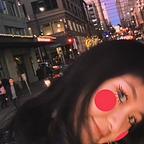HCDE 451 A4: 3D Printed Object — A Heart-Shaped Jewelry Stand ♡
Design
The design for this week is to create a 3D model for prototyping a physical object that would be useful in your everyday life. (The practical value is important!) I decided to make a jewelry stand because I need a cute stand to declutter and organize my jewelry.
This 3D heart-shaped stand model must use 3 of the following primitive operations:
- Extrusion
- Revolution
- Boolean (adding or subtracting one object from another)
I chose to make the jewelry stand a heart-shaped because I personally really like this shape. A heart symbol is not only visually cute but also a powerful symbol that reminds me to explore the little joys in this complicated life.
After sketching out the possible looks for the stand, I tried to build both models for the stands that I drew on the right page.
Reflection
Challenge and Frustrations
It wasn’t my first time to use Rhino, but it was my first time to create a 3D model from sketches on the paper. Luckily I found many tutorials from Youtube and the staff in Fluke Makerspace also helped me a lot. I appreciated.
Designing the model: The biggest challenge when designing this 3D model was trying to draw a legit heart shape that is printable. After showing the following two pictures with the staff, they told me that it was impossible for the 3D printer to print out these two shapes. The first model was failed because the 4 heart shapes were not 3D objects and were missing the tops. The second model was the improved version of the first model because I tried to make the tops by using the patch function. However, I failed again because simply following the Youtube tutorial without truly understand what the patch function is, I created a logically impossible object that doesn’t exist in this three-dimensional world.
Printing out the model: The biggest frustration for me was to add and remove the supporter. Since I only roughly understand the mechanism of the 3D printer, I didn’t know what’s the right place to put the support structure and what kind of structure it should use. I couldn’t manually add the support structure, so I let the system automatically do it for me. In this case, I was grateful when the model was printed out successfully, but when it failed, I didn’t know how to fix it. I printed out three versions in total, but only the first one was successful, and the second and third were all partially failed. The support structure was a mess.
What I Wish I Had Known
It would be great to learn some geometry and know how to turn a 2D shape into a 3D object at the outset. In addition, I wish I had known or at least familiar with all the commands and functionalities that Rhino provides. Due to the lack of familiarity, I used the patch function in the wrong way and wasted much time on creating something impossible to print.
Things I Enjoyed
I am always excited to learn a new skill. I enjoyed the learning and creating process even though there were many frustrations. I like the process of transferring a 2D shape on my sketchbook to a 3D object on Rhino by only using three simple operations. When I first successfully extruded the top surface of the heart, it was one of the exciting moments where I started to imagine how I can create other fancy stuff with this new learning skill.
It was another exciting moment when I was watching my model print. I was impressed by how advanced the technology is.
Pros
- A powerful tool with many useful operations such as revolution
- The measurements and grid system are precise and super useful when making point-to-point intersections
- Provide different angles, top, perspective, front and right of the 3D model
- Many tutorials are available online
Cons
- Complex interface and unfamiliar terminology
- Some icons designs are very similar hence hard to distinguish
- Ambiguous error messages
